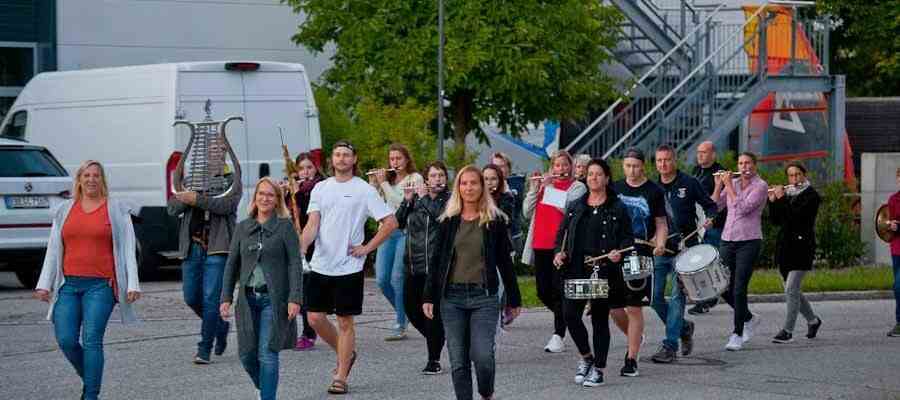Soft pink streaks of cloud adorn the sky above the commercial area near Grafing station, over which dusk is already falling. Only the hum of the car wash disturbs the end of the day. Then marching music breaks the silence. It applies to the marching band, which starts moving at 7:30 p.m. sharp. Because for the 20 people on the train it is a very important time: preparing for the move to the Wiesn next weekend in Munich. The rehearsal times have already been doubled in the past few weeks, so that the preparations for moving into the meadow are now in their final stages. On Monday there was a dress rehearsal, which took place in everyday clothes and without onlookers, but the formation is already in place. So that this also works safely next Saturday, the musicians circled the deserted streets until nightfall.
Especially for the new members, the possibility of a dress rehearsal is a good practice opportunity, in which the repertoire of around 20 pieces is performed by heart while running, says Stefan Pihale, chairman of the association. Well-known pieces such as “The Bozner Bergsteiger”, “Die Brücke am Kwai” or “Ein Jäger aus Kurpfalz” are also included. Mainly through the youth work, the association recruits new, young members. He himself joined the marching band as a child through his father and has been part of the group with his lyre for 38 years. With its lyres ringing as bright as a bell, high flutes dancing like a dance, rhythmic, dark drums and a resounding cymbal, the Grafing marching band is fully and classically cast.
For almost 70 years, the people of Grafing have been part of the Wiesn procession
In keeping with the almost 70-year tradition, the Grafing marching band with the Augustiner Festkapelle will accompany the entry to the Oktoberfest with 40 to 45 musicians at the weekend. On Saturday, the sonorous procession, clad in black and red traditional costumes, will set off from Sendlinger Tor at around 11 a.m. But in contrast to Saturday, when there will be one or two resting opportunities, the seven-kilometer route along Widenmayerstraße along the Isar must be covered on Sunday without a break.
Since 1953, the Grafing marching band has been marching and making music at the Wiesn in Munich, explains Stefan Pihale. The privilege of being able to do without an application came about through the good contact with the Augustiner brewery. The good relationship at that time between a former member of the Grafinger Verein and a waitress from the brewery marked the beginning of the long-standing tradition that still exists today. At least that’s the story.
The Grafing marching band at the Wiesn in 2013.
(Photo: Florian Peljak)
Since then, the entrance to the Wiesn has been the highlight that the assembled musicians are looking forward to. And yet membership is much more than rehearsing every two weeks and performing at the Oktoberfest. Beyond the joy of making music together, says Stefan Pihale, it is the social component that connects the individual members. And it is precisely from the activities and undertakings from which the sense of community emerges that the musical work itself draws.
In addition, the different age groups would also enrich the musical and social get-together. While the younger members could also pick up and memorize new pieces quickly, the older members, with familiarity with the older works, would be able to offer security and orientation to the young musicians. It is the different characters that can bring together the common passion for making music and that is also reflected in the music itself.
Even when the sun had already set behind the commercial area in Grafing, the marching band continued towards the Kiermeier house to put the finishing touches on the rehearsed pieces. When the last tones of the Grafinger marching band died away after a good two hours, the pale pink had long since turned into midnight blue.

